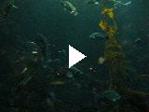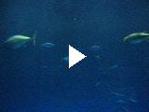I spent all Monday at the Stanford marine research station in Monterey, talking with scientists about their research. Most life in the ocean is limited by the amount of nutrients in the water (mostly nitrogen and phosphorus), but most nutrients are found deep in the ocean where there is no light and plants can’t survive. The most productive locations are where ocean currents push deep water to the surface, brining nutrients to plants. Monterey Bay is one of these places, and the waters outside the marine station were filled with noises of seals, sea birds, and otters.
There are signs that this bay has already changed due to a changing climate. A survey of the bay in the 1930’s and then again in the 1990s show that the species living in the bay changed. Between those time periods, a majority of species that are usually found in southern waters increased in abundance, while species that are usually found in northern waters decreased in abundance, suggesting that as the earth has warmed over the past century, the ecosystem has changed.
I talked with Dr. George Somero (the one holding the fake fish in the picture), who studies the effect of heat stress on marine organisms. His research has shown that many of the creatures living in tide pools are living near their the upper limit in temperature, and a small increase in summer temperature will likely kill many of the species in bay, allowing others to take their place. As shown by the study I referenced in the previous paragraph, most animals have evolved to live in a certain climate. When we change the climate in the next 100 years, as we are doing, the plants and animals can’t evolve—many will need to move or die, and ecosystems will dramatically change.
I also enjoyed talking with Luke Hunt, a PhD student at the station studying a form of seaweed that clings to rocks in the tidal zone. Using historical photos, Luke has been able to see how the seaweed moves on the rocks between decades. He has found that it is remarkably stable, but that there was a significant jump a few decades ago because the sea level has risen very slowly over this period. Luke told me that “even though the climate changes slowly, the ecosystems response may be sudden.” My favorite part about meeting with Luke, though, was that he lives on a small boat in Monterey harbor. For dinner, he and his wife shared with me feast of beans and quesadillas from the living room/kitchen/dining room (it’s only one room) of the boat.
I received a tour of the Stanford marine station (as well as a couch to sleep that night) from graduate student Tom Oliver. Tom walked around (I made him pose as if explaining something in the below picture), and even took me to the Monterey Bay Aquarium. The movie to the left shows the kelp forest that is found in the bay, as well as the impressive diversity of species. Also, look how big tunas are! They’re big!
As all of this above research has shown, Monterey Bay will change, likely significantly, under climate change, but it the life itself will not collapse (although biodiversity may decrease). This is not the case for coral reefs, which are in huge trouble from both an increase in temperatures and an increase in acidity from higher carbon dioxide levels. Tom, my guide, studies reef genetics, and has been able to say which reefs are more likely to die off because of climate change. I will tell you more about reefs and climate change later, though, when I visit one on my way through Panama. Stay tuned!







Is the changing of the ecosystem a bad thing? I mean, decreasing biodiversity sounds bad, but systems are always changing, adapting, evolving, so why are these anticipated changes considered to be “bad” or “unnatural”? Or are they?
Nice overview of your trip at Monterey. There is so much covered here and I am looking forward to you revisiting these topics later in your trip.
Response to comment 1: Nick, you make a good point. The changes in Monterey bay may not be disastrous, and I cannot point to any science that says that there is a grave social need to avoid climate change in order to save Monterey Bay. The greater threat to the bay is likely over-fishing, and not climate change.
Nonetheless, we can see that this ecosystem is changing due to climate change. Is this change bad? Ecologically, it is likely that these changes will cause extinctions and decrease biodiversity because they are rapid and species cannot adapt quickly enough to move. In general, I think, rapid change is bad, and we are causing rapid change. We cannot exactly predict the change. Many other ecosystems I will be visiting are more vulnerable than Monterey Bay (50% of forests in Mexico are threatened, for instance). The bay, however, is well studied, and we can see some evidence of climate change in the ecosystem, which is why I visited it.